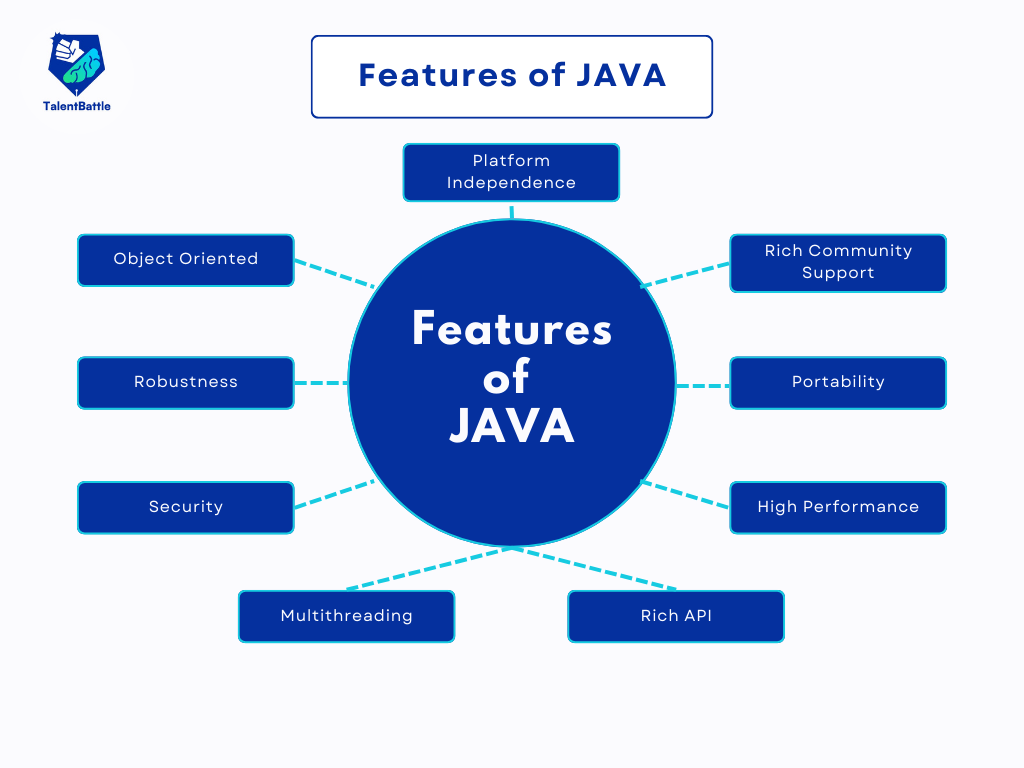.png)
Table of Contents (Click any Topic to view first)
- What is Java ?
- History of Java
- Features of Java
Java is a versatile programming language and a computing platform. It's renowned for its reliability, security, and objectoriented approach. Developed by Sun Microsystems, now owned by Oracle, Java emerged in 1995. James Gosling, often referred to as the father of Java, spearheaded its creation. Initially named Oak, it was renamed Java due to naming conflicts.
One of Java's defining features is its platform independence. Programs written in Java can run on any device or operating system with a Java Runtime Environment (JRE) installed. This characteristic makes Java highly adaptable and widely used in various domains, from web development to mobile applications and enterprise systems.
In essence, Java provides developers with a robust, flexible tool for creating a wide array of software applications that can operate seamlessly across different platforms.
The history and evolution of Java are fascinating, showcasing its journey from inception to becoming one of the most widely used programming languages in the world.
1. Origins (1990s): Java was developed by James Gosling and his team at Sun Microsystems in the early 1990s. Initially named Oak, it was designed for use in consumer electronics, particularly for controlling devices like VCRs. However, with the rise of the internet, the team realized the potential for a language that could run on any device, leading to the evolution of Java.
2. Introduction (1995): Java was officially released to the public in 1995, and it quickly gained attention for its unique features such as platform independence, objectoriented design, and robustness. Its slogan "Write Once, Run Anywhere" reflected its ability to run on any device with a Java Virtual Machine (JVM).
3. Java 2 (1998): In December 1998, Sun Microsystems released Java 2, which introduced significant enhancements to the language and platform. This version included the Swing GUI toolkit, the Collections Framework, and the Java Naming and Directory Interface (JNDI), among other features.
4. Open Sourcing (2006): In an effort to increase adoption and foster communitydriven development, Sun Microsystems opensourced Java under the GNU General Public License (GPL) in November 2006. This move led to the creation of the OpenJDK (Open Java Development Kit), an opensource implementation of the Java Platform, Standard Edition (Java SE).
5. Acquisition by Oracle (2010): Oracle Corporation acquired Sun Microsystems in January 2010, leading to speculation about the future of Java under its new stewardship. Despite initial concerns, Oracle continued to support and develop Java, releasing updates and new versions.
6. Java SE 7, 8, and Beyond: Oracle released Java SE 7 in July 2011, followed by Java SE 8 in March 2014. These versions introduced significant improvements, including the lambda expressions, the Stream API, and the modular system (Project Jigsaw) in Java SE 9. Subsequent releases focused on enhancing performance, security, and developer productivity.
7. Java SE 11 and LongTerm Support (LTS): Java SE 11, released in September 2018, marked a significant milestone as the first LTS version under Oracle's new release cadence. LTS versions receive longterm support and updates, providing stability for enterprise applications.
8. Project Loom and Future Developments: Oracle and the Java community continue to work on various projects aimed at improving Java's performance, scalability, and developer experience. Project Loom, for example, focuses on adding lightweight concurrency primitives to the language, potentially simplifying the development of concurrent applications.

Java boasts a range of features that have contributed to its popularity and widespread adoption across various domains. Here are some of its key features:
1. Platform Independence: Java programs are compiled into bytecode, which can run on any device with a Java Virtual Machine (JVM). This "write once, run anywhere" capability enables Java applications to be portable across different platforms without modification.
2. Object Oriented: Java is built around the concept of objects, allowing developers to create modular, reusable code. It supports principles such as encapsulation, inheritance, and polymorphism, which promote code organization, flexibility, and maintainability.
3. Robustness: Java's robustness is evident in its strong memory management, exception handling, and type safety features. It includes automatic garbage collection, which helps manage memory allocation and deallocation, reducing the risk of memory leaks and system crashes.
4. Security: Java's builtin security features protect against various threats, including viruses, malware, and unauthorized access. It includes a security manager, bytecode verifier, and sandboxing mechanism to enforce security policies and prevent malicious code execution.
5. Multithreading: Java supports multithreading, allowing programs to execute multiple tasks concurrently. This capability is essential for developing responsive and scalable applications, particularly in environments with multiple users or heavy processing loads.
6. Rich API: Java provides a vast array of standard libraries (APIs) covering areas such as networking, I/O, GUI development, database connectivity, and more. These libraries simplify development tasks and accelerate timetomarket for Java applications.
7. High Performance: Java's JustInTime (JIT) compilation and optimization techniques contribute to its high performance. While interpreted at runtime, Java bytecode is compiled into native machine code by the JVM, resulting in efficient execution and competitive performance.
8. Portability: Java's platform independence and standardization make it highly portable across different devices, operating systems, and architectures. This portability extends to both desktop and server environments, making Java suitable for a wide range of deployment scenarios.
9. Community Support: Java benefits from a vast and active community of developers, contributors, and users worldwide. This communitydriven ecosystem provides access to resources, tools, frameworks, and knowledgesharing platforms, fostering innovation and collaboration within the Java ecosystem.


.png)


